Post-Pandemic Mystery at Heathrow
In June 2021, the British Air Accident Investigative Branch (AAIB) initiated a fascinating investigation after they noticed three similar incidents at London Heathrow over a three-day period. Soon, they realised that the three incidents, all involving blocked pitot tubes, were related. As the investigation continued, several more incidents were discovered.
The pitot tube measures the air flow in order to gauge the speed and pressure of the air. There is a pitot tube on either side of the aircraft; each has an open end pointing forwards, so that the air flows in as the aircraft flies.

In 2021, the aviation world was on guard for post-pandemic issues as flights restarted after the pandemic border closures. And it is true that in every instance, the flight crews reported that they had less regular flying practice than they would have in normal (pre-pandemic) times; they were meeting the minimum legal requirements to operate as a commander or co-pilot, but with a lower level of recent flying practice, which, the report says, could cause high-end skill fade and reduced operational fluency.
But actually, the lack of recency did not contribute to the issue. If anything, the flight crews believed that they took things a little slower and paid extra attention to their briefings and checklists, which meant that they were actually quicker to spot and react to the abnormal situations than they might have been in 2019.
The initial incidents were reported across three days in June.
9 June
On the 9th of June, a British Airways Airbus A320, registration G-EUUO, was on its take-off roll. The first officer, as Pilot Monitoring, called “Thrust Set”. This is a confirmation that the thrust lever is set correctly for take-off power and that the engine indications show that the power is being produced.
The captain, who was Pilot Flying, noticed that his Primary Flight Display (PFD) showed less than 40 knots airspeed. He looked to his first officer’s PFD which indicated that they were travelling over 70 knots. The captain rejected the take-off, calling “STOP” at the same time as the first officer called out “one hundred knots”. They brought the aircraft to a halt on the runway and reviewed the aircraft status, including the brake temperatures. There was no obvious fault with the aircraft other than that the captain’s PFD was not correctly indicating airspeed. They taxied back to the terminal.
It turned out that the left pitot probe was blocked with something described as “solid soil type material”. Maintenance replaced the pitot probe and after testing, they released the aircraft for flight.
The Airbus A320 had been in storage at Gatwick for the previous two months and had undergone a standard “return to service” maintenance package which included a pitot/static system flush. The day before, the aircraft had flown from Heathrow to Gatwick and the crew did not experience any issues.
After arriving at Heathrow, the aircraft was parked at maintenance stand TD4 at 03:46 that morning and stayed there until 6am on the 9th, the day of the incident.
10 June
The following day, the flight crew of a second aircraft, another British Airways Airbus A320, registration G-TTNH, saw an unexpected error message as they were pushed back from the stand. The Electronic Centralized Aircraft Monitor (ECAM), which displays systems information and faults, gave a brief alert regarding the rudder travel limiter system.
At the end of the pushback, the captain saw his Primary Flight Display speed scale jump to 160 knots and then drop back down to zero. They began the engine start process with the No. 2 engine. The ECAM began generating alerts for both Radar Altimeter systems and for the first officer’s angle of attack probe. It also displayed a failure message for the No. 1 engine, even though they had not started that engine yet. The Airbus flight control mode switched from Normal Law to Alternate Law, which is effectively the Electronic Flight Control Systems admitting that it doesn’t think it is reliable and is declaring itself unable to provide certain protections in flight.
The flight crew shut down the No. 2 engine and reinitialised the Air Data and Intertial Reference Units (ADIRU) before starting again. The ECAM faults remained. They returned to the stand.
Maintenance found two of the three pitot probes were visibly blocked with debris, similar to what they had discovered in the probe of G-EUUO the day before. They changed the probes and flushed all of the lines, after which the pitot/static probes (and everything else) worked perfectly.
This aircraft had been parked on the stand next to the other Airbus 320 over the same time period, so it seemed likely that this was part of an isolated event to do with those parking bays on the same night.
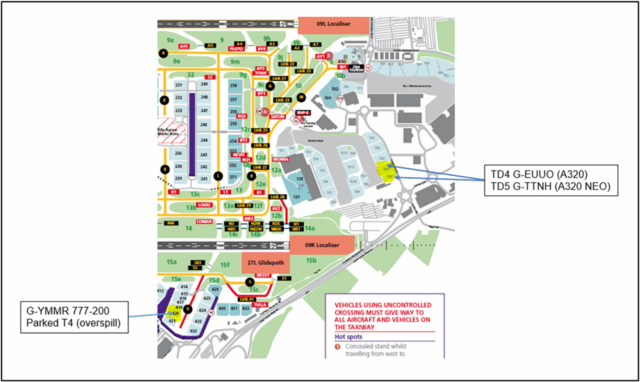
11 June
The third aircraft, a British Airways Boeing 777-236, registration G-YMMR, arrived at Heathrow on the 5th of June and was parked at Terminal 4 for six days, with only a brief visit to a maintenance stand. The Boeing was towed to Terminal 5 for its scheduled flight.
During the take-off roll, just after the Pilot Monitoring confirmed that the take-off thrust was set, both pilots realised that their airspeed indicators were not reading. The captain called “STOP” to abort the take-off and they stopped safely on the runway. The flight crew returned to the stand once they had checked the aircraft status and brake temperatures.
Maintenance found that two of the pitot probes were blocked with debris, similar to the previous two aircraft. However, the Boeing had not been parked in the same area as the two Airbus. This meant that they had a wider issue. British Airways contacted the AAIB and the Boeing was quarantined until the AAIB could come to see for themselves.
The AAIB concluded that insects were the most likely cause of the blockages. The maintenance team removed the probes for further investigation. I never knew this was a job that existed, but the AAIB then asked a corporate beekeeper to assess the blockage and help identify the debris.
The beekeeper pointed out that there was a hard cap at the tip of the pitot which was typical of how solitary bees and wasps block off their nests. Unfortunately, the debris on the inside had been burnt to a crisp during the pitot’s heat cycle, but they were able to narrow the culprit down to a foraging species such as solitary bees.
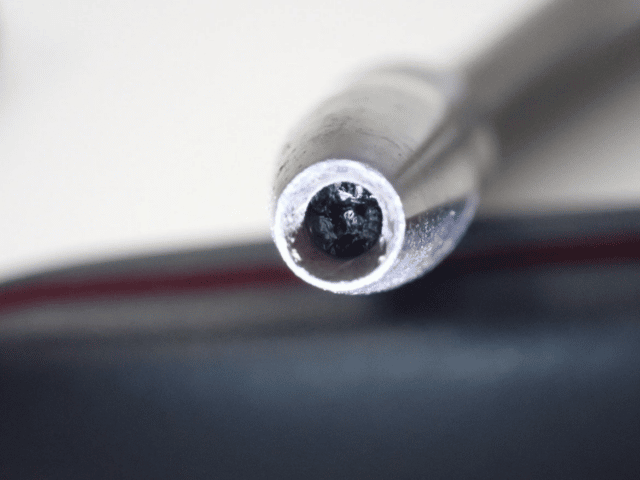
The AAIB also reviewed the information from the previous two incidents. On the AAIB’s advice, the Civil Aviation Authority (CAA) issued a safety notice SN-2021/014 – Pitot blockage events on the 12th of June.
The UK CAA and AAIB have been advised of three separate events occurring at London Heathrow Airport between 9 June 2021 – 11 June 2021, whereby aircraft have been subject of pitot blockages that resulted in airspeed discrepancies and associated crew actions. The cause of these events are the subject of ICAO Annex 13 investigation, which the UK AAIB is undertaking, however initial feedback suggests a form of insect infestation may have contributed to these events.
All three aircraft had undergone a general visual inspection before flight; however, this inspection is done from the ground, which is quite a far way away on an A320 or a B777. The pilots were looking for damage rather than blockages, which are hard to see from the ground.
As a result of the three incidents, British Airways required all aircraft stopping at Heathrow to have a detailed visual inspection within two hours before departure.
This inspection involved getting to within an arm’s length of the pitot probes, using mirrors if necessary. Two hundred and sixty five detailed visual inspections were carried out over the course of four days without finding any more blocked pitot probes.
Then, on the fifth day, they found three.
15 June
The right pitot probe of a Boeing 787-9, registration G-ZBKJ, was blocked with debris and insect eggs. The Boeing had been parked on Stand TA4 for three days.
The right pitot probe of a Boeing 777-300, registration G-STBJ, was blocked after having been parked on stand TA6. This time, the blockage had been detected before the crew had started the engines, so the pitot had not been through a heat cycle.
The nest was undamaged and the larva in the probe were alive! They collected the larva and sent them for analysis.
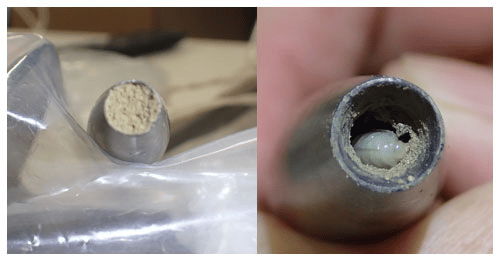
The third aircraft, a Boeing 787-8, registration G-ZBJF, had a blockage in the right pitot probe.
British Airways added a further requirement that all aircraft parked at any engineering stand at Heathrow have pitot covers in place and that pitot covers additionally be fit to any aircraft staying overnight at any location.
Another fortnight passed before the next report.
July
A Virgin Atlantic Airbus A330-343, registration G-VKSS, had been in long-term parking at Manchester until the 17th of June, when it was repositioned to Heathrow. All pitot/static systems were flushed as a part of the maintenance programme at Manchester. From the 17th of June to the 1st of July, the aircraft underwent further maintenance and was parked in three different stands at Heathrow: VA4, 701 and 703.
The maintenance team fitted pitot head covers on the 20th of June in response to the CAA Safety notice.
On the 1st of July, the aircraft went back into service for a scheduled passenger flight to Milan. While climbing away from Heathrow, the ECAM threw up a system alert that the first officer’s pitot probe heater had failed. The first officer switched the air data supply and no further issues were noted during the flight to Milan. The instruments seemed to be normal and reliable; there were no further issues during that flight or for the return
Back at Heathrow, maintenance staff inspected the aircraft and discovered debris at the back of the pitot probe at the connection point.

They also found debris inside the captain’s pitot probe. In this case, the debris was compacted but not cemented, as it had been in previous cases. When they removed the debris, the maintenance team found it consisted of sliced pieces of leaves and dead larvae.
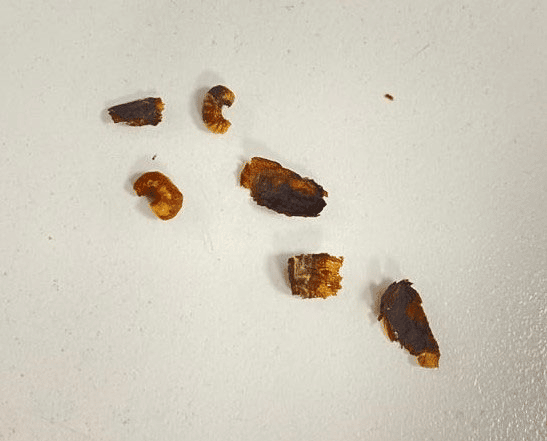
The AAIB sent the larvae for DNA testing. They were identified as Megachile pilidens, more commonly known as the Hairy-toothed small leafcutter bee. The leafcutter bee cuts leaves to line a nest in cavities and forms little cells inside, each containing one larva and a portion of pollen. But intriguingly, these bees are common in Europe, North Africa and parts of Central Asia but are not usually found in the UK.
Following the incident, Virgin Atlantic checked the pitot/static systems of five other aircraft, none of which showed any sign of contamination. Nevertheless, they made a requirement that all aircraft parked for longer than 12 hours at Heathrow or Manchester have pitot covers fitted.
On the 19th of July, an adult insect was spotted, this time in the captain-side pitot probe during the detailed visual inspection on a British Airways Airbus A319-131. The engineers swiftly sealed the pitot probe and removed it, capturing the insect inside. The AAIB gave the insect to the Natural History Museum, who identified it as a female Ancistrocerus parietum, more commonly known as a Wall Mason wasp or Notched Mason wasp. This matched a previous identification of a photograph of an insect crawling into a pitot probe as a Potter or a Mason wasp. Further DNA tests on larvae found in G-STBJ were also confirmed to be the same species.

These wasps commonly use hollow cavities in plant stems as nesting sites and have also been found nesting in window ledges and holes in walls and masonry. The Wall Mason wasp nest can be built in a pre-existing tube in just a few hours.
A completed nest, sealed with a layer of softened clay, would have prevented air flow through the tube. It also created a sealed pressure chamber so, when the pitot was heated, the pressure behind the nest would have increased. This may explain the anomalous airspeed indications seen by the crews on start-up even though the aircraft was stationary.
We usually think of birds when we talk about environmental issues at an airfield, or animals that are able to get onto the grounds and into the runway. Insects are considered a part of “habitat management”: the main reason to control their population is to make the airfield less attractive to birds. Of course, it’s not the first time that insects have blocked pitot probes but it isn’t a common issue. Previously, there had been no need to worry about stowaways at Heathrow but now every aircraft had pitot covers in place.
The AAIB had never seen so many occurrences in such a short time frame. Every aircraft had been checked and flushed before coming to Heathrow, so it was not related to the long periods that the aircraft spent in storage. Neither was it related to the pilots’ lack of recent flying.
Something had changed during the pandemic. But it wasn’t the aircraft or the maintenance or the pilots. It was the airport.
Heathrow Airport, west of London, is one of the busiest airports in the world. During the pandemic, the high level of emissions decreased. The Nitrogen dioxide (NO²) pollution levels dropped all over England but, counter-intuitively, at the same time, the concentration of ground-level ozone increased.
Ozone is essential at a stratospheric level: it protects us from solar emissions. However, ground-level ozone, caused by road traffic, is a pollutant. In urban areas, high levels of NO² in the city degrade the ozone.
NO² is persistent over hours or even days and can be carried by the wind to rural areas. Once it is in areas with lower traffic density and lower volatile organic compounds, the NO² reacts with sunlight and produces ozone.
The result is that as the traffic levels fell, the ground-level ozone concentration increased.
Heathrow, in West London, is located next to two of the UK’s busiest motorways and major mainline railway routes. The decrease in aviation traffic and road traffic meant fewer pollutants but also more ground-level ozone.
Ground-level ozone inhibits floral scents, the volatile organic compounds emitted by flowers that cause them to smell so good. The degraded scents reduce their attractiveness to bees and other foraging insects, who then travel further in search of flowers with pollen. With their natural habitat disrupted by the effective “cloaking” of the flowers, the bees and wasps changed their habits in order to adapt.
There was another, more obvious, change. Seismologists found that across the UK, there was a 50% reduction in vibrations during the pandemic lockdown and urban noise was reduced by 5 db (60% quieter). The airport, usually a significant source of noise and vibrations, would have been much more attractive to animals without the constant traffic.
During the pandemic, this most unhospitable environment had become more inviting, precisely as the increase in ground-level ozone was causing insects to fly further to pollinate. Once in the area, they adapted to the new setting, using pitot tubes as the perfect space in which to build their nests.
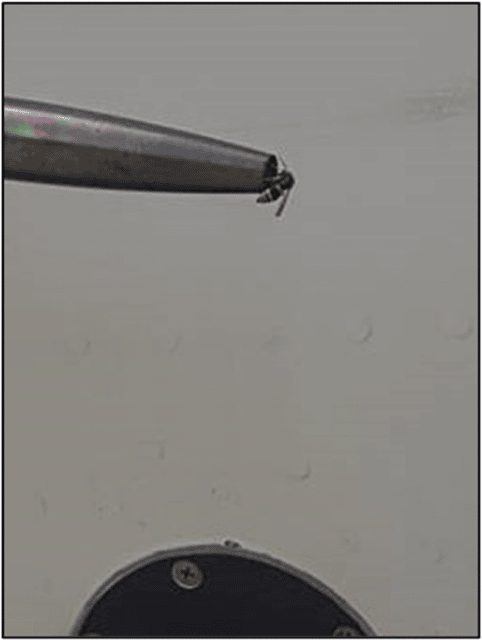
The AAIB report was released in time to issue a warning that the increase in insects in airport environments in 2020 and 2021 meant more insects coming to maturity in the spring of 2022. Heathrow could now suffer from a seasonal risk of blocked pitot tubes. The CAA has published Safety Notice SN-2021/014 to raise awareness of possible long-term ‘insect infestation’ issues.
This isn’t just about the pandemic. As we strive towards greener aviation, with aircraft becoming quieter and cleaner to cause less environmental disruption, we can expect to discover more unexpected issues of this type.
Airport infrastructure and airlines will need to increase their awareness and reporting so that the root causes can be found and dealt with quickly. The pitot blockages in Heathrow were a great example of how this should work: a speedy response combined with public awareness releases to discover how to deal with the immediate issue, followed by thorough checking and a slower investigation to find the root cause. As environmental situations continue to change, this type of investigation will need to be the norm.
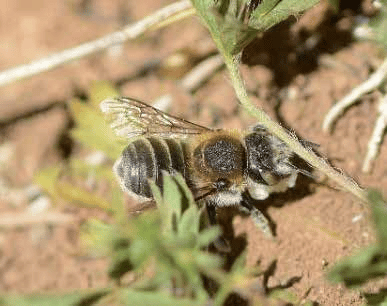
One part of the situation is still a mystery. Most of the incidents were caused by Wall Mason wasps. However, one was positively identified as a Hairy-toothed small leafcutter bee, which is not usually found in the UK. The nest material showed that the leaves had come from a European tree. Now both the bee and the tree type exist in Milan; however, the aircraft was only on the ground for ninety minutes and would have needed some cool-down time before the bee could enter and begin building. This would also mean that there were two blockages: one on the way to Milan, which caused the unreliable air data that the first officer noticed, and another blockage while the aircraft was in Milan. Based on this, it seems more likely that the bee entered the pitot tube while the aircraft was parked for three days in Heathrow …except that if so, it was very lost.
Sadly, it seems we shall probably never find out. Another aviation mystery for us to consider.
You can read the full report in the AAIB Bulletin: 3/2022 (PDF)








Holy cow…
Good idea! More cows around Heathrow will produce more local methane, which will react with and reduce local ozone, which will lead to unmasked blossom scents, which will reduce the stress on Ancistrocerus parietum ( and possibly Megachile pilidens, if present) to extend its forage range, which will keep the little pests out of our pitot tubes.
I laughed out loud at this
Interesting analysis, Sylvia, as always.
Brisbane airport in Australia has been having similar problems with an invasive wasp from the same subfamily Eumeninae (potter or mason wasps):
Inventive nesting behaviour in the keyhole wasp Pachodynerus nasidens Latreille (Hymenoptera: Vespidae) in Australia, and the risk to aviation safety
https://journals.plos.org/plosone/article?id=10.1371/journal.pone.0242063
Thank you!
Interesting story. I like the bit about how the heated blocked tube could create positive pressure, which may account for some of the anomalous readings.
I’d always thought of a pitot tube as blocked or unblocked but there’s quite a few variations within that spectrum.
As far back as I can remember, we have had problems with Mud Wasp making a home out of Pitot tubes at small, country airports. I never saw that problem at a busy, city airport.
I had never given it any thought before but it makes sense, I would not like to live around the parking ramps of a busy airport, why would a bug. It makes sense that the insects return when the noise and pollution are reduced.
Our world is totally connected and interdependent, the most minor change in one location can throw the whole system out of whack. I think Douglas Adams wrote about that.
I’m surprised nestbuilding is a problem at small airports; I’d have thought they’d mostly be used by planes small enough that pilots could reach the pitot tube to put on and take off a cover. I remember using a sort of canvas thimble with a long canvas streamer attached, both bright red for visibility; pilots at the club I learned at were expected to take this off during the walkaround before getting into the plane, and to put it back on right after getting out. (I learned at a USAF-based club — don’t know what the civilian clubs on the other side of the field did.) I can see this not being feasible for something the size of a commercial airliner.